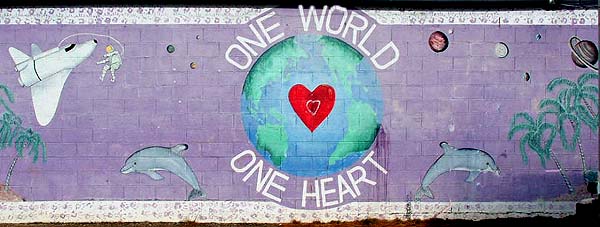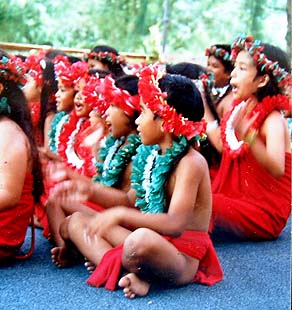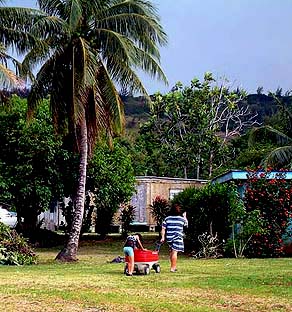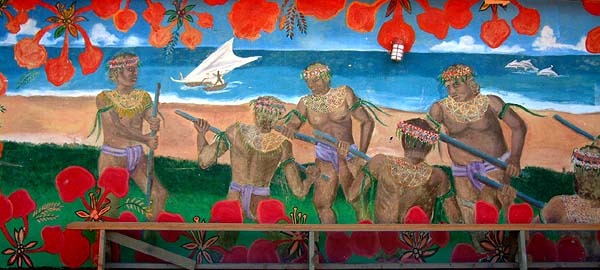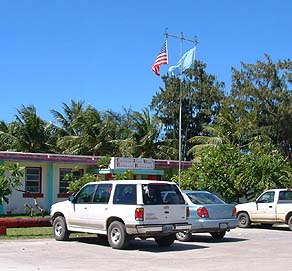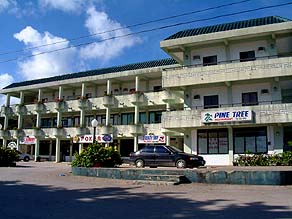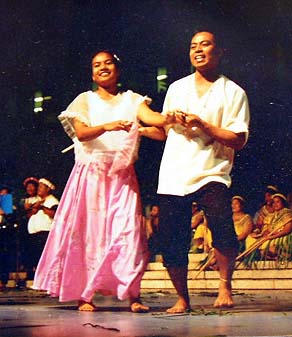 |
 |
 |
|||||
|
|
|
|
|
|
|
|
|
|
|
|||||||
|
|
|
|
|
|
As we depart Tanapag, we ask our guides to share their final thoughts with us, reflecting on all that has been presented here regarding Tanapag, and on the future of the Commonwealth of the Northern Mariana Islands as a whole.
|
||
|
|
||
Dave: “It is very important to preserve the culture. This is part of our tradition that we have to relay to our kids. Whenever you don’t have enough money, you use the culture as part of your life. You can bring a meal into your house by applying the culture. If you don’t have money, but you know how to go fishing and you bring back fish and put it on the table, everybody will eat the fish. "Now we rely on the store because of the money that changes the culture. But the possibility is there to reach out with good people who have more knowledge of the culture, and try to explore the fundaments of our culture."
|
|
|
Ben and Pete: “We’ve changed attitudes and behavior towards our culture,” Ben says. “In the olden days we preserved our food by nature’s way. For example, we’d dig underground, we soaked the breadfruit 3 days in the water, and then put them underground, and that’s supposed to last for many many years. We'd wrap them in banana leaves or taro leaves, put them in the ground, and dig them back up when there's no more breadfruit or when a typhoon comes across. "Today nobody’s doing it. Instead of a firewood kitchen, now we have gas stoves, refrigerators, deep freezers. We’re exposed to so many different cultures now, and the easy ones are normally adopted very quickly." “There’s a different culture coming in,” Pete agrees. “Different culture comes in, and that’s how the tradition is getting lost.”
|
|
|
|
Mural at Tanapag Elementary School.
|
Rosa Castro: “The Chamorro are basically the same as the Carolinians. It looks like we’re one people, Carolinian and Chamorro. I really like the new generation coming after me. But they have to learn about and hold onto the Carolinian and Chamorro customs. If I don’t teach my kids my Carolinian customs, maybe they cannot be friends with the other Carolinians from my family. But I teach them, I explain to them who my mother was, describe our roots, and explain that we are Carolinian and not Chamorro. I don’t know if some families teach their kids about Carolinian words or Carolinian customs. But myself, I teach all my kids.
|
||
|
|
||
“They’re really smart now, the kids today, they’re growing up because of school. Are they going to listen to what I’m going to tell them? I don’t know if in their hearts they’re going to listen to me truly, or if they will come to listen to what I have to say and maybe they won’t agree to do what I tell them. "They can tell me, ‘Hey, things are different now.’ Before, there was no TV, no telephone. So maybe they will say, ‘Forget about it, your culture from before, because before is not this time. This time is American time!’”
|
|
|
Jesus: “Youngsters of yesterday were much better. They respected their elders as compared to today’s youngsters, who are disrespectful to their elders. Today’s youngsters are a lot smarter than yesteryear’s, and it’s difficult to advise them, because they will respond back to the elders, which was not common in the olden days. "I believe the youngsters of today are very important, but they don’t have the interest to listen to their parents and to their elders.”
|
|
|
|
|
Scott: “Education is critical and where it really needs to happen is at the family level. I don't think that education in the schools on these kinds of things is effective. You need to have it reinforced in the homes. That’s where it’s really learned. That’s where your values were learned, and you can’t let teachers take the responsibility of either teaching culture or—I hate to say it—‘family values’ to your kids. “We have encouraged the study of local history and languages, and that’s kind of central to our mission. So whenever we can foster that and encourage it, we do; and I think it’s going to make some difference. But the challenges we’re up against now—I mean anywhere in the world I think it’s the same. It’s not just here. It’s everywhere. It’s a challenging situation.
|
||
|
|
||
Rosa Tenorio: “The American system, democracy, is the only way to go. But sometimes the American government forces themselves on people that are not ready. We have the American customs and we have our own culture, so you have a government on Saipan that’s trying to work under the American system; but yet, on the other hand, you have a culture that’s trying to tolerate the American system. "And it’s going to be years and years. It’s not this generation that’s coming up next and it won’t be the next generation. It’ll be three generations from me that’s going to actually open this Commonwealth as ‘the real America’.”
|
|
|
Lino: “I tend to keep my mouth shut nowadays more than ever, because I started out very strongly, before the whole political change came about, against the whole development. Because like I was saying back then and I keep saying today, we are not ready. And they often ask me, ‘And when are we going to be ready?’ "And I always tell them, only time will tell. At least wait for those kids to come out from colleges, then maybe we should start pursuing the change.”
|
|
|
|
|
Noel: “I just hope there’ll be more people and more agencies supporting every aspect of the culture, so that we can adapt with the change and still retain whatever culturally identifies us for the future generations, for them to know where they come from and how our life has been way back in time. I really hope that our government sees that as a priority, and I really hope that, first and foremost, the people realize that. “You have to link with your past. If you don’t have that knowledge, you’re going to have a hard time identifying yourself: who you are, where you come from, how you came to be where you are right now. Imagine a person doesn’t know anything about their past or their cultural identity, not even how to cook certain things or food or anything like that. You have to link with your past culturally: the traditions, the heritage, the knowledge, the language, all the things that a group of people once were practicing. “It’s modernization that loses your culture. It’s modernization that changes things rapidly to the point where the past is forgotten. It’s nice to go from one place to another using an airplane, but you still should know how our ancestors came to that small island.”
|
||
|
|
||
Sylvestre: "I think Tanapag is one of the very few villages on Saipan that still has these very strong family ties. It’s a small community with only a few family names—Sablan, Kapileo, Taitano, Teigita or Iguel, for example—but big extended families. There are a lot of us. And it has long been practiced, from our early ancestors down, that we would rather stay together, stick together. “Other villages are now mixtures of different ethnic groups or families. But Tanapag is still the same. It’s a village where you find the same families who have been here from the beginning until now. And it is also a fishing village; that has been practiced since the beginning, and that tradition has been passed on from generation after generation and is still in existence today.”
|
|
|
Juan: “I would like to encourage the future generations to be serious about looking back, and to try to bring back the very rich culture. Maybe not all of it, but one cultural aspect in the village that is very rich and must be protected is the unity of the people--regardless of whether people are actually relatives or not. Because when I was growing up, regardless of whether you were a relative or not, if you were a member of this community, and you had work that needed to be done, people from the community would just go there and help. And back then I realized that I could sleep anywhere without my doors being locked, and know deep down in my heart that I’m safe."
|
|
|
|
Sunset off Tanapag.
|
"If we can only bring that back. We’re trying now. We are going to continue to try. How successful we are going to be, I don’t know, but we started seeing a lot of change, and we will continue to make these changes. So my message to the community, and to the young generation, is to try to maintain the close-knit society. It is a very rich and very important part of life.”
Adios, asta ki umali'e' hit ta'lo! Ulee ló!
|
||
|
|
||
|
|
|
|
|
|

|
| Tanapag Home | Map Library | Site Map | Pacific Worlds Home |
|
|
|
|

|
|
|
|||
| Copyright 2003 Pacific Worlds & Associates • Usage Policy • Webmaster |
|||



